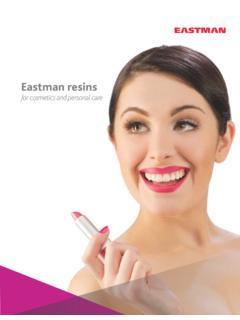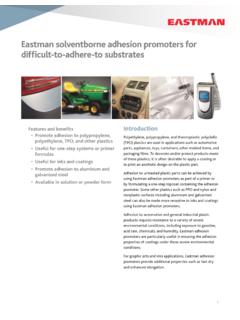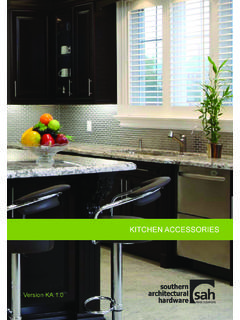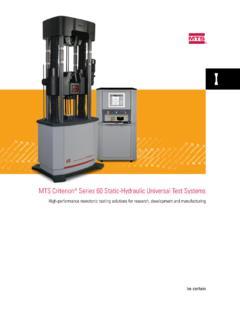Transcription of E-322C Eastman Products for Industrial Wood …
1 Eastman Products for Industrial wood coatings22 ContentsBeauty meets performance 3 Eastman and the Industrial wood coatings market 3 Eastman product families for Industrial wood coatings 3 High performance Products for wood coatings 4 Benefits of cellulose esters 4 Eastman Solus 2100 performance additive 4 Choosing an Eastman CAB resin for initial screening 4 Industrial wood finishes using Eastman cellulose esters 5 Eastman CAB lacquers 6 Polyurethane finishes 6 Acid-cured alkyd/amino conversion varnishes 6 Precatalyzed lacquers 7 Eastek polymer dispersions 9 Solvents 9 Ketones 9 Esters 10 Alcohols 10 Glycol ethers and glycol ether esters 10 Additives 11 Eastman SAIB (sucrose acetate isobutyrate) 11 Eastman Optifilm enhancer 400 11 Plasticizers 11 Adhesion promoters 113 Beauty meets performanceAt Eastman , our raw materials enhance the appearance, performance, and protection capabilities of Industrial wood coatings and finishes.
2 These Products allow coatings formulators to create clear, beautiful, and durable finishes all while balancing cost and Products meet global performance and appearance requirements ensuring that quality is never compromised and that The Material Difference is unmistakable. Eastman and the Industrial wood coatings marketEastman Chemical Company supplies solutions for the formulating needs of the Industrial wood coatings market. Our Products allow formulators to satisfy important market drivers such as higher performance, optimized unit cost, appearance, and regulatory requirements. Eastman has a broad range of raw materials for Industrial wood coatings applications and is committed to developing innovative solutions that will create value for the coatings formulator. Eastman offers these solutions for finishes on residential furniture, office and institutional furniture, cabinetry, building Products , and other wood-based composite Products for Industrial wood coatingsEastman product families for Industrial wood coatingsCellulose esters Eastman CABE astek polymer dispersions Eastek 1000, 1100, 1200, 1400 Solvents Ketones Esters Alcohols Glycol ethers and glycol ether estersAdditives Eastman SAIB (sucrose acetate isobutyrate) Eastman plasticizers Eastman Solus 2100 performance additiveAdhesion promotersFor various wood plastic composites Solventborne: chlorinated and nonchlorinated Waterborne.
3 Chlorinated and nonchlorinated Photographs on pages 1, 6, 7 were reproduced with the permission of Products for Industrial wood coatings (continued)High performance Products for wood coatingsEastman cellulose esters, as a family of polymers, offer a wide range of performance-enhancing properties for wood coatings. They are supplied as 100% solids, free-flowing powders and can be dissolved in a variety of solvents and reactive CAB (cellulose acetate butyrate) resins have been used in wood-coatings systems for many years. They find widespread use in high quality 2K acrylic urethane systems and in the growing trend towards radiation-curable systems. Besides these principal coatings applications, Eastman CAB is also used in thermoplastic and acid-curable of cellulose estersCellulose esters offer wood coatings systems a variety of advantages including: Fast hardness development allowing early stacking and processing of coated Products Nonyellowing under influence of UV light Excellent flow and leveling characteristics resulting in defect reduction and improved coating appearance Achieving the correct balance of viscosity and solids content which allows excellent wetting, penetration, and pore definition on open pore wood species Superior control of silica matting aids allowing consistent gloss levels at a variety of film thicknesses Reduced variation of film thickness due to picture framing Improved atomization User-friendly application characteristics Improved adhesion (UV systems) Resistance to plasticizer migrationEastman Solus 2100 performance additiveEastman Solus 2100 performance additive possesses improved compatibility with alkyd resins commonly used in wood coatings formulations as compared to cellulose esters.
4 Alkyd urethane wood coatings for furniture are typically formulated utilizing nitrocellulose resins particularly where low gloss is required. One of the main issues with this approach has been that the nitrocellulose binders impart excessive yellowing in the coating, even more so than the short oil alkyd and aromatic isocyanate incorporation of Solus 2100 performance additive into an alkyd urethane wood coating offers the following benefits: Improved resistance to yellowing under UV light Improved dry-to-touch time and hardness development Excellent flow/leveling and appearance Higher solids content at application viscosity giving lower VOC levelsChoosing an Eastman CAB resin for initial screeningThe unique structure and composition of cellulose ester materials allow us to modify key attributes of the Products to alter solubility, compatibility, hydroxyl content, and molecular weight. This provides a range of Products that offers coatings formulators a wide variety of formulation how cellulose esters are named, one can easily make relative comparisons among them for initial screening in any application.
5 Three variables butyryl content, hydroxyl content, and viscosity determine which cellulose ester to screen for a given application. These variables are described by the nomenclature for cellulose Products for Industrial wood coatings (continued) Eastman CAB nomenclatureEastman cellulose esters For a cellulose ester with greater: Choose a cellulose ester with:CompatibilityHigher butyryl contentSolubility Higher butyryl content or higher hydroxyl content if the solvent blend is high in alcoholReactivityHigher hydroxyl contentToughnessHigher viscosityHardnessLower butyryl content or higher hydroxyl contentChemical resistanceLower butyryl contentFlexibilityHigher butyryl contentHigher solids at fixed viscosityLower viscosityMoisture resistanceLower hydroxyl contentAdhesionHigher butyryl and hydroxyl contentGenerally, Eastman CABs with higher butyryl content are best for initial screening due to greater compatibility with other resins.
6 If compatibility is good with the higher butyryl esters, others may then be evaluated. In many cases, a lower butyryl ester may be incompatible with a system while a higher butyryl ester shows good compatibility. Testing is advised to determine compatibility with the resin of your choice. Type of wood finishTypical use level, solids, wt%Suggested Eastman performance additive for initial screeningLacquer 30 , alkyd/urea 10 precatalyzed 10 10 polyurethane 5 , , , solids20 , , Solus 2100 High solids 5 , Solus 2100UV-curable 1 , , Solus 2100 Unsaturated polyester 1 , wood finishes using Eastman cellulose estersFor more than 40 years, Eastman CABs and Eastman CAPs have been used as coresins or additive raw materials providing a number of benefits to 2K PU/acrylics, acid-cured, UV-curing, and other wood coatings , the molecular structure of cellulose ester chains provides unique rheological properties. Eastman CAB solutions demonstrate almost Newtonian flow behavior at certain shear domains allowing excellent atomization, flow, and leveling very quickly after application.
7 The elastic modulus predominates over viscous modulus resulting in fast hardness development and excellent film ofHydroxl Groupsper FourAnhydroglucose UnitsApproximateButyryl Contentat the Triester,wt % CAB lacquersLacquers based on cellulosic resins are versatile wood finishes. The main advantages of CAB over nitrocellulose are that it is nonyellowing, and has superior cold check resistance and lower flammability. CAB is the best choice for those finishes where nonyellowing is required. CAB/acrylic lacquers are also particularly suitable as topcoats for light-colored wood or light-shaded CAB/acrylic lacquers maintain traditional lacquer qualities, such as ease of repair, ease of handling, fast drying, clarity, and superior tips for lacquers Eastman CAB has limited compatibility with alkyd resins. However, if formulated with an alkyd resin, the slowest evaporating solvent in the system should be an aromatic hydrocarbon to ensure blush-free films.
8 It is important to include some aromatic hydrocarbon in the solvent blend to help achieve overall compatibility, solution clarity, and smoothness of Eastman CAB lacquers while reducing solvent costs. Lacquers containing Eastman CAB should not be mixed with those containing nitrocellulose because they are generally incompatible. Compatibility with alkyds may vary depending on the alkyd type. Testing has shown greater compatibility with resins based on coconut, castor, and soya oils. Eastman suggests testing with your alkyd to confirm compatibility. Additional information is available from your Eastman representative. Solus 2100 performance additive has shown better capability with alkyd resins and is recommended for use in 2K polyurethane alkyd finishesPolyurethane wood finishes exhibit outstanding film properties and are commonly used in top quality furniture with high demand for appearance and chemical resistance. Drying rates, flowout in particular on open pore wood species and surface smoothness can be improved by incorporating Eastman CAB into polyurethane finishes.
9 Most polyurethane formulations are composed of Eastman CAB, polyisocyanate resins, and/or hydroxyl-functional acrylic or polyol resins. The hydroxyls on the Eastman CAB molecules react with isocyanate to form tough, durable urethane networks in addition to the lacquer-like application properties that Eastman CAB provides these coatings. Existing pure polyurethane/acrylic systems may also be modified with low levels (1% 10%) of Eastman CAB to improve flow properties and drying tips for polyurethane finishes No alcohol or water should be present in the solvents; use only urethane grade solvents. Aliphatic isocyanate resins are recommended for better compatibility and they provide better color stability and yellowing resistance. A slight molar excess of isocyanate to hydroxyl functionalities helps ensure superior chemical alkyd/amino conversion varnishesConversion varnishes combine the fast-curing properties of a lacquer with the higher-performance properties of alkali, solvent, water, and heat resistance of a varnish.
10 The incorporation of Eastman CAB imparts lacquer-like handling to this type of coating. Acid-catalyzed Eastman CAB finishes may also be formulated with hydroxyl functional acrylic resins in place of alkyds for nonyellowing Products for Industrial wood coatings (continued)7 Formulating tips for acid-cured alkyd/amino conversion varnishes High alcohol content in the solvent blend will stabilize the coating and extend catalyzed pot life. p-Toluenesulfonic acid (pTSA) is often used as a catalyst. Weaker catalysts, such as acid phosphates, will extend pot life but slow cure response. In most cases, 3% pTSA catalyst, based on solids, will provide maximum cure response. Additional catalyst will not improve coating properties and could cause hydrolysis of butyrate esters. The hydrolysis reaction forms butyric acid, which will have little effect on film properties but will cause an unpleasant lacquersEastman CAB/acrylic precatalyzed lacquers are an excellent choice for applications where the discoloration of conventional nitrocellulose/alkyd precatalyzed lacquers is unacceptable.













![INDEX [hosesolutions.com.au]](/cache/preview/0/e/a/7/e/3/f/9/thumb-0ea7e3f9ea4b923c6b71ff3ae5ad9a01.jpg)
